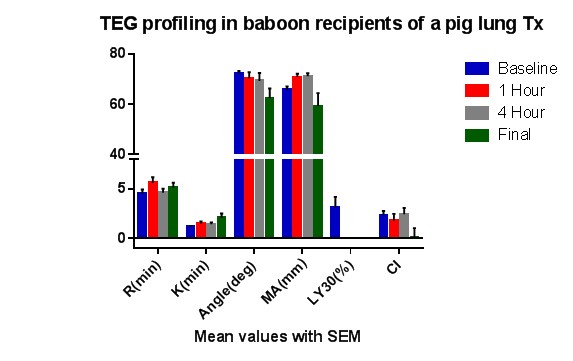Coagulation Pathway Perturbations Associated with Pig-to-Baboon Lung Xenotransplantation.
Department of Surgery, University of Maryland, School of Medicine, Baltimore, MD
Meeting: 2017 American Transplant Congress
Abstract number: B305
Keywords: Anticoagulation, Lung transplantation, Xenotransplantation
Session Information
Session Name: Poster Session B: Xenotransplantation
Session Type: Poster Session
Date: Sunday, April 30, 2017
Session Time: 6:00pm-7:00pm
 Presentation Time: 6:00pm-7:00pm
Presentation Time: 6:00pm-7:00pm
Location: Hall D1
Aim Dysregulation of coagulation is associated with graft failure in multiple xenotransplantation models. This study describes thromboelastographic profiles in baboon recipients of a genetically engineered left pig lung.
Methods Venous baboon blood was collected into 3.2% citrated tubes at baseline (n=17), at 1 (n=13) and 4 hours (n=11) after graft revascularization, and pre-explant at lung graft demise, 5-192 hours after transplant (n=7), and promptly evaluated by TEG (Haemoscope 5000) after kaolin activation, using heparinase cups where indicated. Baboons received GalTKO.hCD46 pig lungs that also expressed one or more additional protective genes (hCD55, hEPCR, hTBM, TFPI, hCD47, hCD39, or HO-1).
Results In comparison to baseline, MA (platelet-dependent clot firmness) increased significant at 1 and 4 hours (p 0.005, 0.003 respectively), while physiologic clot lysis (LY30) became undetectable. (Figure) The time to initial clot formation (R) and rate of clot build-up (K) tended to increase progressively as grafts failed, while the rate of clot formation (angle), MA and CI (integrity of clot formation) declined significantly at graft demise. This pattern was consistent across lung genotypes tested here.
Conclusions Pig-to-baboon lung xenotransplantation is associated with a hypercoagulable TEG profile during the first 4 hours post-tx, whereas a hypocoagulable state exists around the time of subsequent lung demise. We conclude that lung xenografts trigger consumptive coagulopathy that is not fully constrained by the pig genetics tested here. TEG should be useful as a tool to quantify and manage the consumptive coagulopathy observed in this and other primate xeno models, and measure effects associated with new pig gene combinations and other candidate treatment strategies.
CITATION INFORMATION: Sendil S, French B, Siddiqui O, Parsell D, Laird C, Cimeno A, Dahi S, Burdorf L, Azimzadeh A, Pierson III R. Coagulation Pathway Perturbations Associated with Pig-to-Baboon Lung Xenotransplantation. Am J Transplant. 2017;17 (suppl 3).
To cite this abstract in AMA style:
Sendil S, French B, Siddiqui O, Parsell D, Laird C, Cimeno A, Dahi S, Burdorf L, Azimzadeh A, III RPierson. Coagulation Pathway Perturbations Associated with Pig-to-Baboon Lung Xenotransplantation. [abstract]. Am J Transplant. 2017; 17 (suppl 3). https://atcmeetingabstracts.com/abstract/coagulation-pathway-perturbations-associated-with-pig-to-baboon-lung-xenotransplantation/. Accessed December 14, 2025.« Back to 2017 American Transplant Congress
